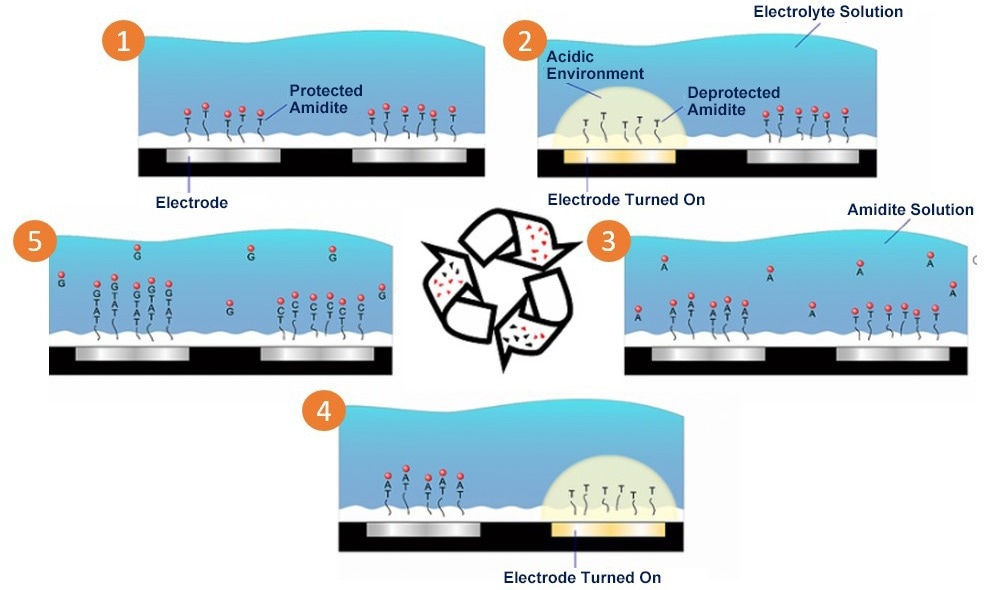Sponsored Content by GenScriptReviewed by Maria OsipovaNov 16 2022
In a new application for CRISPR/Cas editing tools, researchers at Harvard Medical School, Boston, Massachusetts, have created a CRISPR/Cas9 ribonucleoprotein-based peptide display approach.
This technique is hoped to simplify the peptide library analysis workflow by using a new technique called peptide immobilization by Cas9-mediated self-organization (PICASSO).
This unprecedented usage of CRISPR/Cas tools is based on the utilization of a tweaked Cas9 that is both inactivated (dCas9) and coupled to a peptide sequence. The peptide fused-dCas9 is supplied onto a DNA microarray using RNA barcodes (gRNA), where the ribonucleoprotein complex self-assembles to corresponding DNA sequences.
Fluorescently labeled antibodies enable the readout after the introduction of samples of interest, like antibodies from human serum. This method, when paired with saturation mutagenesis libraries, has the potential to provide high-throughput antibody-epitope binding tests, facilitating antibody-drug and vaccine development.
The technology behind DNA microarrays
CustomArray’s semiconductor technology allows for precise DNA synthesis and printing at specified locations on a solid surface, allowing for greater design flexibility in DNA microarrays. As microarrays are made up of single-stranded DNA oligos, Barber and colleagues employed a primer annealing and extension step to create double-stranded DNA microarrays that could be utilized to detect fused-dCas9 complex-specific binding.

DNA synthesis by semiconductor technology. Precise DNA synthesis is enabled by semiconductor technology, electrochemical techniques, and phosphoramidite oligo synthesis chemistry. Electrochemically generated acid is used at individual electrodes with standard phosphoramidite chemistries to synthesize unique DNA probes. 1. Protected nucleotides are bound to an adhesion layer above electrodes. 2. Nucleotides are deprotected when an electrode is activated. 3–5. A new phosporamidite is added, and the amidite couples only to deprotected nucleotides on the array. Repeating these steps generates oligonucleotide sequences. Image Credit: GenScript

Marcelo Caraballo, Senior Scientist at CustomArray, shared a recent unique design used for testing their new CustomArray’s miniature semiconductor HD (8 million oligos) chip. Image Credit: GenScript
Picasso's technique of proof of concept
In a playful template of DNA microarray that was designed by leveraging the positioning of on-target and off-target DNA sequences, Barber and colleagues were able to replicate the bull’s head from a Pablo Picasso’s sketch, artfully demonstrating the conserved binding specificity of fused-dCas9.
They discovered that peptide fused-dCas9 retained dCas9-like DNA binding properties and that peptide sequences had no effect on gRNA or DNA binding, proving the practicality of dCas9-based peptide display using the PICASSO method.
The researchers concentrated on two human diseases, influenza and COVID-19, to test the efficacy of this technique for the investigation of antibody-epitope interactions. PICASSO microarrays were used to test the binding of convalescent serum-derived antibodies to saturation mutagenesis libraries of influenza A or SARS-CoV-2 peptides.
Interestingly, the antibody-epitope binding profiles determined by PICASSO were highly associated with earlier phage display results.
The advantages of a CRISPR/Cas9-based peptide display
There are numerous advantages to using this newly designed CRISPR/Cas-based Peptide Library Display technology. First, the scientists discovered that by encoding the fused-dCas9 and gRNA within a single vector, it was easy to multiplex the expression and purification of CRISPR/Cas complexes, enabling the utilization of a single E. coli culture.
Second, the self-assembly of gRNA barcoded and pooled ribonucleotide complexes onto DNA microarrays significantly expedited and facilitated peptide library analysis. Finally, Barber and colleagues noted that the ability to reuse DNA microarrays after protease treatment made PICASSO a more cost-effective approach over synthetic peptide microarrays.
Reference
- Barber KW, Shrock E, Elledge SJ. CRISPR-based peptide library display and programmable microarray self-assembly for rapid quantitative protein binding assays. Mol Cell. (2021). doi: 10.1016/j.molcel.2021.07.027.
About GenScript
Genscript is the world’s leading biotech company providing life sciences services and products. With gene synthesis, peptide, protein, antibody and preclinical drug development service capabilities, we are internationally recognized as a leading biotech company specializing in fundamental life sciences research and early-phase drug discovery services. As of 2018, more than 30,000 peer-reviewed journal articles cited GenScript’s services and products, making GenScript the most frequently cited biotech company in the world.
After almost two decades of fast growth in developing biological reagents, the company has expanded its business into immunotherapy, CDMO, laboratory equipment, and microbial industry to further fulfill its mission in making people and nature healthier through biotechnology.
Founded in 2002 in New Jersey, United States, GenScript serves as a partner for researchers in basic life sciences, translational and biomedical fields as well as early-stage drug development.
Sponsored Content Policy: News-Medical.net publishes articles and related content that may be derived from sources where we have existing commercial relationships, provided such content adds value to the core editorial ethos of News-Medical.Net which is to educate and inform site visitors interested in medical research, science, medical devices and treatments.